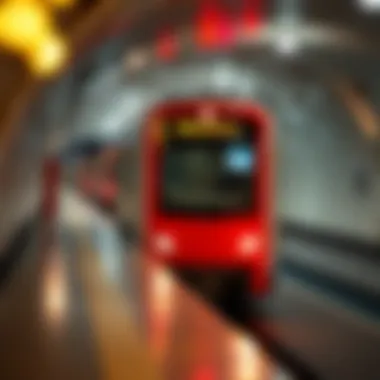Understanding Dubai Metro Time and Scheduling


Market Insights
Understanding the dynamic interplay between public transport systems like the Dubai Metro and real estate trends is crucial for investors and homeowners alike. The metro serves as an artery, channeling commuters from various locales into the heart of Dubai, thus significantly impacting property values and demand.
Current Property Trends
The Dubai real estate market has experienced a notable resurgence over the last few years. Properties located near Metro stations, particularly in areas such as Dubai Marina and Downtown Dubai, have become increasingly sought after. Investors are keenly aware that the proximity to the Metro often enhances the accessibility of these properties, making them more desirable for both renters and buyers.
- Recent studies suggest that apartments within walking distance of Metro stations see an average price appreciation of 5-10% annually, outpacing the city's overall growth rate. This trend highlights the critical role public transport plays in shaping property value.
Investment Opportunities
With Dubai's ambitious plans for expansion and sustainability, opportunities abound for savvy investors. Here are a few key aspects to consider:
- Upcoming Station Developments: Keeping an eye on the city’s expanding metro lines can unveil promising investment prospects. New stations in burgeoning areas like Dubai South or the Expo 2020 site could lead to property value spikes.
- Commercial Properties: Businesses are increasingly seeking locations close to Metro stations to attract foot traffic. Investing in commercial real estate within a short walking distance from metros can secure high rental yields.
- Sustainability Initiatives: Dubai aims to be a global leader in sustainability by 2040. Properties that adhere to green building practices and are near public transport hubs may enjoy additional incentives, making them attractive for eco-conscious investors.
"Investing in properties near the Dubai Metro is not just about location; it’s about understanding the pulse of the city’s economy and lifestyle."
Practical Tips
Guide to Buying Property
When considering purchasing property in Dubai, here are some practical steps:
- Research Thoroughly: Use online platforms and tools like Property Finder or Dubizzle to compare locations and prices.
- Seek Local Expertise: Working with a reputable real estate agent who understands the intricacies of the market can save time and money.
- Know the Rules: Familiarize yourself with property ownership laws, particularly if you’re a foreign investor. The Dubai Land Department offers resources that can guide you through the process.
- Consider Financial Options: Assess mortgages available to expatriates vs. locals. Various banks offer different conditions.
Renting vs. Buying: What You Need to Know
For those mulling over whether to rent or buy, several factors come into play:
- Flexibility Needs: Renting can provide greater freedom for those not ready to settle long-term, while buying is advantageous for those looking to invest long term.
- Market Trends: If the rental market is buoyant, it might be wise to rent until property prices stabilize or decline.
- Cost Analysis: Examine the long-term costs associated with buying, such as maintenance fees and property taxes, versus the short-term obligations of renting.
Prelims to Metro Dubai
Dubai has seen a transformative evolution in its transport systems over the past few decades. The Metro Dubai, in particular, stands out as a key element of this change. This section serves to highlight the significance of the Metro in this context, not just for the daily commuter but also for investors, property owners, and urban planners.
The Dubai Metro is more than just a mode of transport; it is a lifeline connecting various parts of the city, thus facilitating economic activities and social interactions. With its extensive network and state-of-the-art facilities, it serves as a model of modern public transit systems in metropolitan areas. For those looking at the Dubai real estate market, understanding the Metro's operation hours and schedule can be pivotal. Whether you're a tenant looking for convenience, a homeowner considering proximity to transit, or a developer eyeing investment opportunities, the Metro’s influence is undeniable.
Overview of Dubai's Transport Infrastructure
Dubai's transport infrastructure is a well-oiled machine, designed to support the relentless growth of one of the world's most dynamic cities. Beyond the Metro are various other transportation options like buses, taxis, and even water taxis.
- Buses: A complementary service, buses cover areas not reachable by the Metro. They're widely available and well-timed to connect seamlessly with Metro operations.
- Taxis: Convenient and ubiquitous, taxis can be found throughout the city. They've also adopted tech advancements, allowing for easy booking through apps.
- Water Taxis: For a more unique experience, water taxis offer scenic views and connect various spots along the coast and the Creek.
These interconnected systems mean that residents and visitors alike can traverse the city with relative ease, making it feasible to work, shop, and enjoy entertainment without requiring reliance on personal vehicles.
Historical Context of Metro Development


The inception of the Dubai Metro is a fascinating tale of ambition and innovation. Launched in September 2009, the project was a response to Dubai's rapid population growth and the increasing challenges of urban mobility.
Key milestones include:
- 2005: Initial discussions began, focusing on the need for a public transportation system to cater to the burgeoning population.
- 2006: Construction commenced, and the world watched as Dubai set its sights on creating one of the first fully automated metro systems in the world.
- 2009: The Green Line opened, followed by the Red Line, which significantly enhanced connectivity across major urban areas like the Burj Khalifa and Dubai Mall.
The Metro not only eased traffic congestion but also became a symbol of Dubai's commitment to sustainability and innovation. Its automated systems and eco-friendly designs positioned the city as a pioneer in modern transport solutions, attracting attention globally.
The history of the Metro is critical to understanding its impact today, revealing how far the city has come in terms of infrastructure planning and execution. As we delve deeper into the implications of the Metro's operational hours and scheduling, it becomes clear how this system is integral to Dubai's economic ecosystem and urban lifestyle.
Operational Hours of Dubai Metro
Understanding the operational hours of Metro Dubai serves as the backbone of efficient commuting in this bustling metropolis. The Metro is not just a means of transportation; it shapes the everyday lives of residents and visitors alike. Knowing the ins and outs of its schedule allows for seamless travel, affording individuals the ability to maximize their time in a city that thrives on speed and advancement.
Regular Weekday Timings
The Dubai Metro operates during convenient hours that cater to the working population. Typically, on regular weekdays, the service runs from 5 AM to midnight. This encompasses the peak hours in the morning and evening, designed to accommodate the workforce commuting to and from their respective jobs.
Here's a breakdown of peak and off-peak hours:
- Morning Peak (5 AM - 9 AM): Aimed at getting commuters to their workspaces efficiently, trains come at intervals of approximately 2 to 4 minutes.
- Midday Off-Peak (9 AM - 4 PM): The frequency ramps down slightly to every 7–10 minutes, providing some breathing space on the trains.
- Evening Peak (4 PM - 8 PM): As people finish their workday, intervals drop back to around 3–5 minutes.
- Late Night (8 PM - Midnight): Services taper off again with trains operating every 10–15 minutes.
During these times, the Metro can be bustling, often packed during commuting hours, so patience is key.
Weekend and Holiday Schedules
Come the weekends—Friday and Saturday—the Metro adjusts its operations to cater to leisure travelers. On these days, the Metro operates from 10 AM to 1 AM, allowing for late night rides back from shopping malls, restaurants, and other hotspots.
Special considerations apply on public holidays and significant festive seasons; for instance, during the holy month of Ramadan, the schedule shifts to keep in mind the altered routines of worship and fasting.
Special Event Timings
Dubai often hosts high-profile events, exhibitions, and festivals. For these occasions, the Metro has flexibilities in its scheduling to accommodate the influx of visitors.
The approach varies depending on the event, but here’s what typically happens:
- Increased Frequency: During events like the Dubai Shopping Festival, frequency could increase to manage higher passenger volumes.
- Extended Hours: Special circumstances like New Year's Eve result in extended operating hours up to 2 AM to sandwich the festivities.
To sum it up, being clued into the operational hours of the Metro is crucial for both residents and potential investors. It enhances day-to-day activities and can make or break real estate decisions based on convenience and accessibility.
"Access to reliable transport can significantly affect both property values and the quality of life."
By engaging with this information, not just regular riders, but also homeowners and investors can make informed choices to leverage the Metro’s convenience for their benefit.
Factors Affecting Metro Dubai Schedule
Understanding the factors that impact the Dubai Metro schedule is crucial for anyone relying on this transport system. With a city as vibrant and bustling as Dubai, the timeliness and efficiency of the Metro have far-reaching implications for residents, tourists, and even businesses. The operational hours are not set in stone; they adapt to several elements that can enhance or disrupt the typical routine. Keeping track of these factors can help commuters plan better and avoid unnecessary delays.
Public Holidays and Festive Seasons


Every culture celebrates holidays, and Dubai is no different. Public holidays create a unique challenge and opportunity for the Metro's scheduling. During festive seasons like Eid or National Day, the ridership increases significantly. This surge necessitates changes in schedule to accommodate the growing number of passengers. With people flocking to malls, events, and celebrations, the Metro adjusts its hours, often extending service late into the night.
- Key Considerations:
- Recognize that some holidays might lead to shorter operating hours instead of extended ones, especially if the public holiday falls on a weekday.
- Special promotions or events related to these holidays might also trigger a need for a revised timetable.
Commuters should remain vigilant during these times, checking for official announcements for any schedule changes on the RTA website.
Routine Maintenance and Upgrades
Maintenance is the backbone of any reliable transport system. The Dubai Metro is no exception; routine checks and necessary upgrades ensure it runs smoothly and safely. The schedule for maintenance is often communicated well in advance, allowing passengers to adjust their plans accordingly. This can lead to partial or complete service suspensions on certain lines, affecting daily commuters significantly.
- Important Points:
- Advance notice is typically provided via RTA announcements, allowing users to plan for alternative routes.
- Maintenance often occurs during off-peak hours to minimize disruption, but certain schedules may still be heavily affected.
A well-maintained Metro service not only enhances user experience but also protects the investment made by authorities and businesses in the growing Dubai infrastructure landscape.
Emergency Protocols and Adjustments
Unforeseen circumstances can throw a wrench in even the best-planned schedules. Emergencies, whether they're weather-related, mechanical failures, or even security alerts, demand quick thinking and adaptability from the system operators. The Metro system has stringent protocols in place to deal with these unexpected hiccups, aiming to restore normality as swiftly as possible.
- Considerable Factors Include:
- Communication during emergencies is critical. Updates are relayed through announcements and the Metro App, which help passengers stay informed.
- Some emergencies might trigger expanded operational hours if deemed necessary to support the public.
When it comes to urban transport, flexibility is essential. The ability of the Metro to adapt to emergencies speaks volumes about its operational agility and commitment to passenger safety.
In summary, being informed about these factors not only aids in personal convenience but also allows for a more profound understanding of how the Dubai Metro evolves within a rapidly changing urban environment. Commuters, investors, and city planners alike must pay attention to these dynamics, considering how they affect the broader economic picture in Dubai.
Navigating Metro Dubai Effectively
Navigating the intricate system of Metro Dubai is more than just hopping on a train. It's about harnessing the power of a transport network that connects the dots of this sprawling city. For anyone living or investing in Dubai, understanding how to navigate the Metro effectively can significantly enhance daily commutes and overall city experience. This section delves into practical methods and considerations to make the most of the Metro system, which is often seen as the backbone of the city's public transport efficiency.
Using the Metro App for Real-Time Updates
In today's digital age, having information at your fingertips is crucial, and the Metro Dubai application provides just that. This app is an essential tool that allows users to track train arrivals, plan their journeys, and check for service updates that could impact travel.
Benefits of the Metro App
- Real-Time Tracking: Users can monitor the exact location and estimated arrival of trains, helping avoid long waits, especially during rush hours.
- Route Planning: Inputting your departure station and destination gives you the quickest routes and transfer details.
- Alerts and Notifications: It sends updates on any service interruptions or changes to schedules promptly.
Impact of Metro Timing on Dubai's Real Estate Market
The relationship between the operational timings of the Dubai Metro and the real estate market in the city is profound. Metro timings play a pivotal role in shaping the daily lives of countless residents, influencing where they choose to live and work. Reliable and convenient transit options not only enhance the quality of life for current residents but also attract potential buyers and investors eager to capitalize on Dubai's thriving property sector.
Convenience for Residents and Commuters
One of the most significant advantages of the Dubai Metro’s operational schedule is the convenience it offers. Regular commuters, whether they are heading to work, school, or social gatherings, rely heavily on the predictability of train schedules. The metro runs with such frequency that waiting times become minimal, encouraging even those who might typically use a car to consider public transport.


Residents living in proximity to metro stations often state that access to public transport is a deciding factor when selecting their homes. Being adjacent to a metro line means that individuals can allot more time for leisure and family, rather than navigating the busy roads and traffic jams that Dubai is notorious for. This convenience is not just a minor perk; it is a game changer in fast-paced urban life.
Influence on Property Values Near Metro Stations
Another cornerstone of the impact of metro timings relates to property values in neighborhoods situated near stations. Research consistently indicates that properties located within walking distance of metro stations tend to command higher prices compared to those further away. According to various real estate studies, properties located within a 500-meter radius of a metro station can experience value increases ranging from 10% to 30%.
"In urban planning, access to reliable transit options is a top-tier priority for both developers and buyers."
The ongoing improvements and the commitment to expanding the metro lines only enhance this trend further. Buyers are increasingly aware that investing in properties with close proximity to metro stations is likely to yield better long-term investment returns, should they wish to sell or lease their homes down the line. This economic phenomenon underscores the need for buyers to meticulously consider metro timings when evaluating potential properties.
Attracting Investors and Business Opportunities
The relationship between metro timings and the attraction of real estate investors is a compelling story worth telling. More than just a mode of transportation, the Dubai Metro has proven to be a catalyst for economic growth within the city. Investors keen on maximizing their yields are increasingly analyzing how metro coverage and operational hours can influence foot traffic and commercial viability.
With the metro's expansion plans cemented in Dubai’s future, interest among real estate developers is surging. They are eager to develop commercial spaces near stations, knowing that substantial foot traffic translates to better business opportunities. Moreover, well-timed operational hours align closely with the working hours of businesses, enhancing the overall attractiveness of these locations.
Investors are not just looking at today’s market; they are considering future trends. As urban development mounts alongside continuous improvements in metro service operations, those with foresight can carve out profitable niches, establishing a presence at the right location and the right time.
Future of Metro Dubai: Predicting Changes
As Dubai continues to evolve into one of the most dynamic cities globally, its Metro system must not only keep pace but also anticipate the changing needs of its growing population and visitors. The future of Metro Dubai is poised to reflect a blend of technological advancements and strategic urban planning, ensuring the city remains accessible to everyone. Understanding these future developments is pivotal for investors, homeowners, real estate agents, tenants, and developers, all of whom play a crucial role in the real estate market influenced by public transport.
Anticipated Extensions and New Lines
The Metropolitan area of Dubai is sprawling and continuously developing, which signifies the necessity for Metro extensions. Plans have been laid out to expand existing lines and introduce new routes that connect vital districts and suburban areas.
- Red Line Extensions: One of the primary focuses will be the extension of the existing Red Line. This line serves numerous key areas, and the envisioned extension aims to reach further into suburban locales, thereby enhancing connectivity for residents living in these parts.
- Blue and Green Lines: Future developments may potentially include more lines or expansions of the Blue and Green lines, which currently serve varied demographics and economic hubs. This evolution can boost property values in those neighborhoods and promise higher foot traffic for businesses.
- Integration with the Mobility-as-a-Service (MaaS): Dubai plans to integrate its metro system with other forms of transport, including buses, taxis, and even water taxis. This comprehensive network aims to facilitate smoother transitions from one transport mode to another, increasing overall efficiency.
- Sustainable Initiatives: As a city that prioritizes sustainability, future expansions will also focus on environmental considerations, such as solar-powered metro stations and electric trains. This approach not only addresses climate concerns but can also become attractive selling points for eco-conscious citizens.
Looking ahead, the integrated transport network is not just about getting from A to B; it's about enhancing quality of life in the bustling metropolis of Dubai.
Adapting to Increased Demand
With continuous population growth and an influx of tourists, adapting to increased demand for Metro services is essential. The current forecasts hint at a steep rise in daily ridership, and the Dubai Metro must evolve to accommodate this surge.
- Capacity Expansion: One of the most immediate ways to adapt is by enhancing train frequency during peak hours. This will reduce waiting times and prevent overcrowding. A timetable overhaul can ensure that more trains are operating when they are needed most.
- Technological Upgrades: Investing in technology for better traffic management is imperative. Implementing AI and smart systems can facilitate real-time updates, allowing passengers to have accurate information on delays and train arrivals.
- Passenger Comfort: Increased capacity should also consider passenger comfort to create a pleasant commuting experience. This may involve upgrading the trains with better seating, air conditioning, and navigation systems that guide users through stations with ease.
- Economic Considerations: For real estate agents and investors, these enhancements can translate to higher tenant satisfaction and retention, increasing the attractiveness of properties near Metro stations.
In summary, the future of Metro Dubai is geared towards making the city's transport network more responsive, efficient, and sustainable. Keeping an eye on these predicted changes will aid those involved in the Dubai real estate market to make informed decisions that capitalize on the expanding infrastructure.
Culmination: The Significance of Metro Time Management
In the hustle and bustle of Dubai’s ever-evolving urban landscape, the management of Metro time stands as a cornerstone of effective transportation and economic vitality. Understanding the operational hours and the nuances involved in scheduling is not just a matter of convenience; it plays a critical role in the functioning of the city itself. For commuters, residents, and investors alike, keeping a keen eye on the Metro's timing can unlock a myriad of opportunities while also shaping daily routines and future plans.
Proper time management allows the Dubai Metro to optimize its services, ensuring that it meets the demands of a growing population. Moreover, it creates an efficient flow of travelers from point A to B, reducing traffic congestion significantly. With the influx of new investors and business ventures, having a reliable transit system directly affects property values and attractiveness of locations near Metro stations.
Recap of Key Insights
As we distill the key insights from the analysis of Metro Dubai’s time management, several points stand out:
- Operational Efficiency: The Metro operates on a well-structured schedule that caters effectively to peak and off-peak hours, ensuring minimal wait times for passengers.
- Adaptability: The scheduling is flexible to accommodate public holidays, maintenance works, and special events, reflecting a forward-thinking approach to public transport.
- Economic Relevance: The link between Metro timing and the booming real estate market cannot be understated. The convenience of access contributes to heightened interest and property value surges in surrounding areas.
- Technology Integration: The integration of mobile apps for real-time updates enhances the commuting experience, making it easier for users to plan trips around the Metro schedule.
Final Thoughts on Metro's Role in Dubai's Growth
In contemplating the broader implications of Metro time management, one cannot overlook its fundamental role in shaping Dubai’s growth narrative. The Metro is not merely a mode of transportation; it's a vital artery that pumps life into the economic engine of the city. As Dubai continues to burgeon as a global hub for business and tourism, the Metro's operational prowess becomes increasingly crucial.
A well-timed Metro can encourage local businesses, facilitate tourism, and open gateways to investment opportunities. As we look to the future, with anticipated extensions and modernizations of the Metro system, the rail network will likely serve as the benchmark for urban transit solutions in other developing cities. Thus, understanding and appreciating the significance of Metro time management is imperative—not just for daily commuters but for everyone who has a stake in the growth of this dynamic city.















